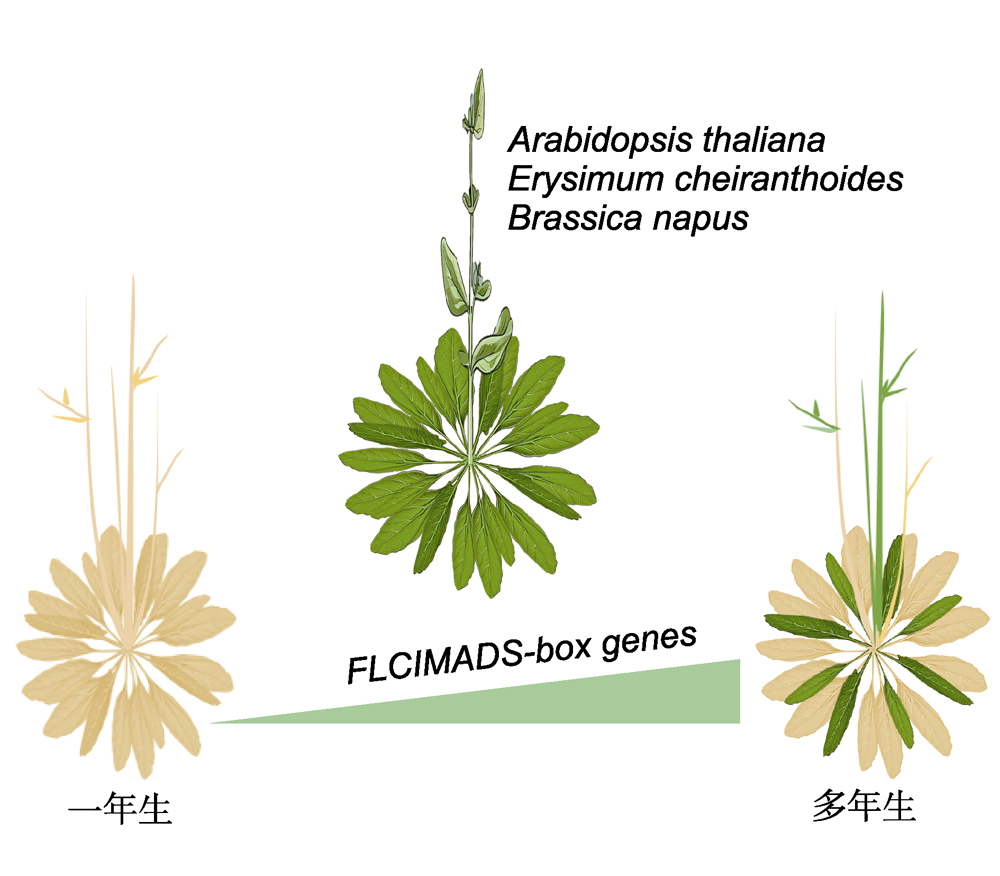

长寿与短命: 十字花科植物中MADS-box基因的长袖善舞
收稿日期: 2024-05-19
录用日期: 2024-05-23
网络出版日期: 2024-05-28
基金资助
国家自然科学基金(32341038);国家自然科学基金(32322063);新基石研究员项目(NCI202341)
MADS-box Genes Driven Life History Strategy Diversity in Brassicaceae
Received date: 2024-05-19
Accepted date: 2024-05-23
Online published: 2024-05-28
开花基因决定植物的一年生或多年生开花习性。已在不同植物中鉴定到多个开花基因, 然而关于开花基因如何驱动十字花科植物一年生与多年生生活史策略转变的进化机制仍不清楚。最近一项研究聚焦十字花科不同属的自然变异, 发现3个亲缘关系密切的MADS-box类转录因子编码基因(即FLC、FLM和MAF)与其一年生/多年生习性转变相关, 并解析了其分子机制, 提出十字花科植物生活史策略(即多年生/二年生/一年生之间的转换)是由FLC类MADS-box基因剂量叠加所决定的连续过程。研究结果初步明确了十字花科植物一年生与多年生生活史策略转换的进化机制和轨迹, 为培育多年生油菜品种奠定了理论基础, 也为其它十字花科作物的多年生化遗传改良提供借鉴。

廉小平 , Getachew Melaku , 张石来 , 胡凤益 . 长寿与短命: 十字花科植物中MADS-box基因的长袖善舞[J]. 植物学报, 2024 , 59(3) : 351 -354 . DOI: 10.11983/CBB24076
The numerous flowering genes that have been identified in different plants play a crucial role in determining whether a plant is annual or perennial. However, the evolutionary mechanism by which these flowering genes drive the transition between annual and perennial life history strategies in Brassicaceae plants remains poorly understood. A recent study focused on natural variations in different genera of Brassicaceae. They identified three closely related MADS-box transcription factor genes, namely FLC, FLM, and MAF, and elucidated their molecular mechanisms associated with the transition between annual and perennial behavior. Their findings suggest that the life-history strategy in Brassicaceae plants (i.e., the conversion between perennial, biennial, and annual behavior) is a continuum determined by the dosage of FLC-like MADS-box genes. The study elucidates the evolutionary mechanisms and trajectories underlying the reciprocal conversion of life history strategies from annual to perennial in Brassicaceae, providing a theoretical foundation for breeding perennial rapeseed varieties and offering insights for Brassicaceae crops improved towards perennial grain.

Key words: Brassicaceae; life history strategy; MADS-box; perennial; annual; transition
| [1] | Cox TS, Glover JD, Van Tassel DL, Cox CM, DeHaan LR (2006). Prospects for developing perennial grain crops. Bioscience 56, 649-659. |
| [2] | Crews TE, Carton W, Olsson L (2018). Is the future of agriculture perennial? Imperatives and opportunities to reinvent agriculture by shifting from annual monocultures to perennial polycultures. Global Sust 1, e11. |
| [3] | Friedman J (2020). The evolution of annual and perennial plant life histories: ecological correlates and genetic me- chanisms. Annu Rev Ecol Evol Syst 51, 461-481. |
| [4] | Friedman J, Rubin MJ (2015). All in good time: understanding annual and perennial strategies in plants. Am J Bot 102, 497-499. |
| [5] | Gao Z, He YH (2024). Molecular epigenetic understanding of winter memory in Arabidopsis. Plant Physiol 194, 1952-1961. |
| [6] | Glover JD, Reganold JP, Bell LW, Borevitz J, Brummer EC, Buckler ES, Cox CM, Cox TS, Crews TE, Culman SW, DeHaan LR, Eriksson D, Gill BS, Holland J, Hu F, Hulke BS, Ibrahim AMH, Jackson W, Jones SS, Murray SC, Paterson AH, Ploschuk E, Sacks EJ, Snapp S, Tao D, Van Tassel DL, Wade LJ, Wyse DL, Xu Y (2010). Increased food and ecosystem security via perennial grains: perennial grains hold promise, especially for marginal landscapes or with limited resources where annual versions struggle. Science 328, 1638-1639. |
| [7] | Hu FY, Tao DY, Sacks E, Fu BY, Xu P, Li J, Yang Y, McNally K, Khush GS, Paterson AH, Li ZK (2003). Convergent evolution of perenniality in rice and sorghum. Proc Natl Acad Sci USA 100, 4050-4054. |
| [8] | Jackson W (1980). New Roots for Agriculture. Lincoln: University of Nebraska Press. pp. 93-115. |
| [9] | Li Z, Lathe RS, Li JP, He H, Bhalerao RP (2022). Towards understanding the biological foundations of perenniality. Trends Plant Sci 27, 56-68. |
| [10] | Luo X, He YH (2020). Experiencing winter for spring flo- wering: a molecular epigenetic perspective on vernalization. J Integr Plant Biol 62, 104-117. |
| [11] | Sheldon CC, Burn JE, Perez PP, Metzger J, Edwards JA, Peacock WJ, Dennis ES (1999). The FLF MADS box gene: a repressor of flowering in Arabidopsis regulated by vernalization and methylation. Plant Cell 11, 445-458. |
| [12] | Stearns SC, Fawcett TE (2013). Life-history theory: an o- verview. Annu Rev Ecol Evol Syst 44, 145-171. |
| [13] | Tan FC, Swain SM (2006). Genetics of flower initiation and development in annual and perennial plants. Physiol Plant 128, 8-17. |
| [14] | Xu SJ, Chong K (2018). Remembering winter through vernalisation. Nat Plants 4, 997-1009. |
| [15] | Zhai D, Zhang LY, Li LZ, Xu ZG, Liu XL, Shang GD, Zhao B, Gao J, Wang FX, Wang JW (2024). Reciprocal conversion between annual and polycarpic perennial flowering behavior in the Brassicaceae. Cell Doi: 10.1016/j.cell.2024.04.047 |
| [16] | Zhang SL, Huang GF, Zhang YJ, Lv XT, Wan KJ, Liang J, Feng YP, Dao JR, Wu SK, Zhang L, Yang X, Lian XP, Huang LY, Shao L, Zhang J, Qin SW, Tao DY, Crews TE, Sacks EJ, Lyu J, Wade LJ, Hu FY (2023). Sustained productivity and agronomic potential of perennial rice. Nat Sustain 6, 28-38. |
| [17] | Zhou CM, Zhang TQ, Wang X, Yu S, Lian H, Tang HB, Feng ZY, Zozomova-Lihová J, Wang JW (2013). Molecular basis of age-dependent vernalization in Cardamine flexuosa. Science 340, 1097-1100. |
/
| 〈 |
|
〉 |